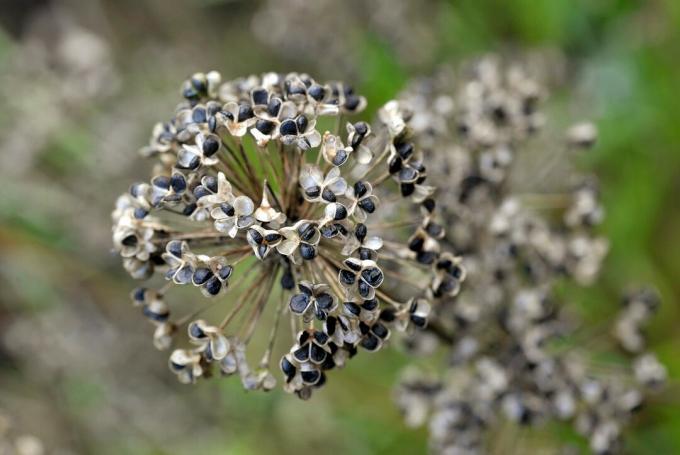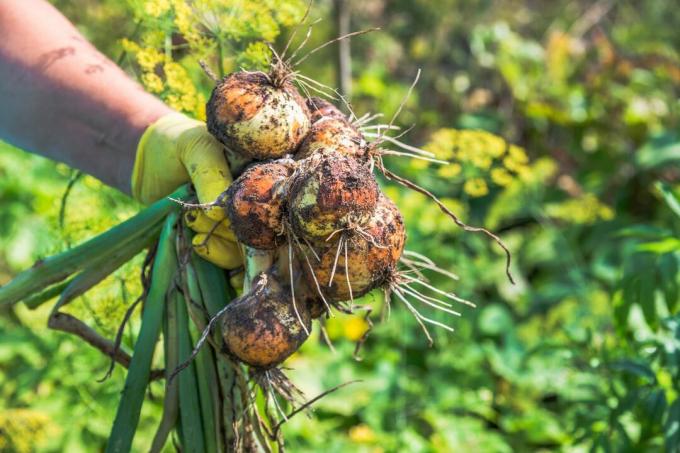Onions go well with a variety of different dishes. Here's everything you need to know about planting onions in your own garden.

The onion (Allium cepa) is one of the most popular vegetables ever. It belongs to the Amaryllis family (Amaryllidaceae). Whether braised, fried or raw, onions are a must in many dishes, as they give every meal a special touch. Even if its origin cannot be clearly defined, it feels very comfortable in the temperate latitudes of Central Europe. We will show you how you can successfully grow onions yourself, what needs to be considered when caring for them and give step-by-step instructions for planting and harvesting onions.
contents
-
Plant onions and plug them in correctly
- Stick onions: the right location
- Time to stick the onions
- Procedure for sticking onions
- Growing Onions: Quick Guide
-
Buy onions or grow them yourself
- Buy onion sets
- Grow your own onion sets
- Propagating onions from seeds
- Onion varieties: Variety for the garden and kitchen
-
Cultivate onions in your own garden
- Fertilize onions
- pour onions
-
Harvest and store onions
- harvest onions
- store onions
Plant onions and plug them in correctly
The onion can also be propagated from seed, but most gardeners stick their bulbs. This is more convenient and usually associated with more success. We explain what is important when sticking onions.
Stick onions: the right location
Onions thrive best on loess and clay soil. The balanced nutrient balance, the high proportion of humus and the constant supply make this soil the perfect location. If you don't find optimal conditions in your garden for growing onions, you can work compost into your onion bed. It is particularly important that the soil is deeply loosened. The loosening stimulates soil life and aerates the deeper layers. The onions can unfold more easily this way.

Tip: Would you like to grow onions in a tub or on the balcony? No problem! It is only important that the bucket is big enough so that new daughter bulbs can form.
Time to stick the onions
You shouldn't poke your bulbs before the end of April. The onion sets contain a lot of water and are therefore sensitive to cold. From the end of April, night frosts can be ruled out and the soil temperature is high enough to ensure rapid juvenile growth. Note: "Summer" varieties are usually planted in domestic gardens. As described above, these are only planted in April. There are also winter varieties that can be planted as early as August. You can then harvest the first onions as early as late May.
Procedure for sticking onions
Before sticking, the bed should be loosened up well. Plant your onion sets so deep that the base of the shoot just sticks out of the ground. The planting distances should be at least 15 cm in the row, leave a space of 25 cm between the rows. Tacking them neatly in rows will also make it easier to take care of your bulbs later (chopping weeds, etc.).

Growing Onions: Quick Guide
- loosen soil; possibly. Mix in the compost (preferably in autumn!)
- Sow onion seeds at the end of February / plant onion sets at the end of April
- Only plant onions so deep that the shoot base is on the surface of the earth
- row spacing 25 cm; Distance within the row at least 15 cm
- Chop weeds regularly to prevent competition
Buy onions or grow them yourself
Buy onion sets
Onion sets are the surest way to a bountiful onion harvest. You can buy onion sets in any well-stocked specialist shop or conveniently order them from various online mail order companies. Depending on the variety, you can buy a bag with 250 grams of onion sets for as little as €1.80.
Grow your own onion sets
After the first year of cultivation, you can propagate your freshly harvested onions yourself. Simply harvest and dry the tubers as previously described. Some onion varieties can also be propagated by division. To do this, cut through the tuber along the base of the shoot so that it is divided in the middle. It is important that both halves of the onion contain part of the shoot and root base, otherwise it cannot sprout.

Notice: The propagation of commercially available kitchen onions is usually characterized by little success, since they have often been stored for a long time and also come from grafted varieties. When refining, high-yield varieties with a special taste are placed on a resistant base. Refining vegetables is possible at home, but involves a lot of effort and is not always crowned with success.
Propagating onions from seeds
If you want to accompany your onions from the beginning of germination, you can also buy onion seeds. The variety is huge. A sachet of onion seeds is very affordable and is available from online retailers or well-stocked local retailers for as little as €0.80. Onion seeds can be sown directly in the garden in February or grown into small onion seedlings in pots beforehand.

tip: If you like it easy, you should buy onion sets. These are very affordable and usually promise greater harvest success!
Onion varieties: Variety for the garden and kitchen
There is a wide range of onion varieties. They can be roughly divided into kitchen onions and vegetable onions. We have put together a small selection of different varieties for you and explain the differences and special features:
Onions (rather small and spicy)
- Tonda Musona: White variety; tasty and easy to store
- Rossa di Tuscany: Traditional red variety from Italy; round shape; intense taste
- Zittau Yellow: Proven onion variety; firm consistency; good flavor
- Texas Early: late-ripening, yellow variety; larger onions; bountiful yields and good aroma
Green onions (rather large and mild)
- Exhibition: Lush onion; aromatic; Onions can weigh up to 1.5 kg
- The Kelsae: English variety; very mild and large; Bumper harvest: 6 kg heavy onion!
- Alisa Craig: Also English variety; mild aroma; large onions (>700g)
You can find more onion varieties and facts in our variety article here.
Cultivate onions in your own garden
The onion itself is relatively easy to care for. Nevertheless, you should pay attention to a few things so that the onion harvest turns out well. We will tell you what is important when caring for onions.
Fertilize onions
Onions are light to medium consuming plants. Adding compost in autumn is a good way to enrich the soil with nutrients and have a positive effect on the structure of the soil. Subsequent application of fertilizer is then not necessary. Alternatively, a dose of primarily organic can also be given in the spring Organic Tomato Fertilizer be deployed. The potassium it contains promotes good storability thanks to stable cell walls. It is important to incorporate the fertilizer well and cover it with soil, as too much organic matter directly on the surface can promote the appearance of the onion fly.
pour onions
Onions like it moderately moist. When watering onions, you should make sure that there is no waterlogging. Depending on the weather, regular watering at longer intervals is the best way to provide your bulbs with adequate water.
Harvest and store onions
The spicy onion is a perennial favorite in the kitchen and is used in cooking all year round. We'll tell you how to harvest your onions and how to preserve and store them for the rest of the year.
harvest onions
The onions are ripe and storable from the beginning of August. No garden tools are required to harvest the onions. Simply pull your bulbs out of the ground by the leaves and spread them out side by side on the garden floor. Stored in this way, the outer skins of the onions can dry for several days and thus become durable.

Important: Turn your onions regularly while drying!
store onions
When the outer skins of the onions have dried, they can be stored. You can store your bulbs either hanging or lying flat. To hang bulbs, simply tie them together at the base of the leaves and hang in a dark, cool, dry place.
Notice: Do not store onions next to potatoes! The potatoes give off a lot of moisture, which the dry onion skins easily absorb.
In our special article we explain how to stick onions should, and give expert tips.
